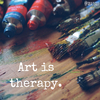Making Art Work: Keeping it Original
“Welcome to the Making Art Work Series! Through this accumulating and growing collection of resource articles, we hope to give insight and suggestions to artists in their journey to becoming their most successful creative selves!”
In a world where “everything’s been done before” it is important to embrace the concept of originality in your artwork. Hopefully, the topics in this article will help identify how this can benefit your work!
What “Original” means: There is a large field of discussion about the very term. An “original” piece of work is considered as follows:
“Not secondary, derivative or imitative.” And “Being the first instance or source from which a copy, reproduction or translation is or can be made.”
Source: https://www.merriam-webster.com/dictionary/original
By these definitions, an original work is something that cannot be related to an established source. As an artist, other works of art can influence your style, but the core elements of your art should be your own.
The importance of originality: As an artist, it is important to understand the value of originality and its place in the artistic field. Originality is essential, as it lends people a unique platform to get their point of view across in a way that only they can. If someone only copies already existing work from other people, they are missing the opportunity for true self-expression, instead, settling for redundancy.
Legal ramifications: Copyright, Trademark and Intellectual Property Rights. These terms should cross every artist’s mind when developing new work if you are intending to sell your work or reproduce with intent to sell. Knowing and respecting these legal boundaries will ensure protection from such things as cease and desist letters, takedown notices and other potential business troubles. In turn, any original content you make can also be protected in similar fashion.
Avoiding confusion: Not one recognizes every famous idea, let alone the person who created it. This, in the business world, is called “Brand Confusion” and can cause a good deal of harm in the eyes of public perception, including yourself. Infringing on an existing copyright or property has many downsides, and one of them can be causing people to think you are the sole owner of the property, which holds a myriad of legal woes. There are ways to circumvent these issues, but in the long run it is better to avoid this issue by making your own content.
Make it your own: When in doubt, make it your own. A classic example of this is Alan Moore’s “The Watchmen” comic book. The original book was intended to be based on DC Comic Book characters, but DC refused to let such an extreme story be told with their properties. As a response, Alan and Dave Gibbons created a new sete of iconic characters inspired by those original comics. This is a grand example of taking something and making it your own. The same can be done in the fine art world, where taking inspiration from something,-- the essence and not the content,-- is the most successful way of letting existing work drive you to create art that will exist under its own merits.
Reference photos: Reference photos can often serve as an aid when creating your own work. Most reference photos obtained through an online source are hard to rely on for being copyright free. It can also be diffictul to determine if those photos have certian legal protections such as royalties, licensing agreements, etc. It is best to search for work on sites that have good reputations for hosting copyright and trademark-free photos. Take note of the following sites that utilize this service:
https://www.pexels.com/royalty-free-images/
We hope this is helpful to you! Did we miss anything you wanted to talk about? Let us know in the comments! Stay tuned to thalo.com for more articles and topics on navigating art and the artist.







